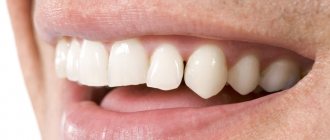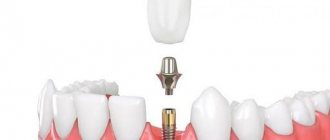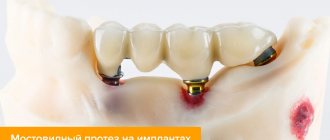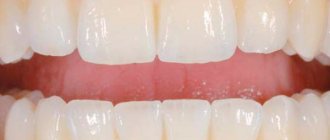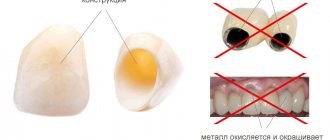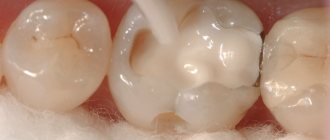Types of fillings
When visiting a dentist, your doctor may offer fillings made from various materials. The most common are the following:
- Cement. They have excellent strength, but do not differ in aesthetics.
- Composite. The most aesthetic option, but the strength leaves much to be desired.
- Light. The most popular fillings that harden by polymerization with a blue lamp.
- Plastic. Such fillings darken very quickly and are clearly not suitable for the restoration of front teeth.
Cost of treatment of front teeth
Dr. Razumenko's dental clinic is one of the leading medical clinics in Moscow, providing front row restoration services using the latest equipment and materials. Our specialists are well acquainted with innovative surgical, restorative and therapeutic techniques; we guarantee high-quality and affordable consultation, timely diagnosis, and high-quality dental care. The price of treatment depends on the individual health characteristics of the patient, the presence of complications and the degree of damage to the lower or upper teeth - the cost of treating initial caries will be significantly lower than the cost of regenerating a destroyed organ with a focus of inflammation.
To find out how much it costs to treat caries of the front teeth, make an appointment with Dr. Razumenko’s dentistry by calling: 8 (495) 380-01-38.
| Code no. | NAME OF PROCEDURES | Unit of measurement | Cost, rub. |
| Anesthesia | |||
| 300 | Application anesthesia | 150,00 | |
| 301 | Infiltration anesthesia, conduction | 550,00 | |
| Treatment of caries | |||
| 303 | Medium caries (US, cavity formation) | 700,00 | |
| 304 | Deep caries (ultrasound, cavity formation) | 900,00 | |
| 305 | Placement of a light-composite filling (Esthet-X, Filtek) | 3 500,00 | |
| 307 | Placement of a light-composite filling (Sonicfil, Estelite) | 3 950,00 | |
| 309 | Recovery from significant damage is simple | 1 unit | 4 000,00 |
| General procedures for the treatment of caries | |||
| 319 | Removing an old filling | 300,00 | |
| 321 | Glass ionomer cement insulating gasket | 500,00 | |
| 322 | Therapeutic pad (calcium-containing) | 300,00 | |
| 324 | Temporary light-curing filling | 600,00 | |
| 325 | Temporary combined filling after root canal treatment | 800,00 | |
| Mechanical processing of channels | |||
| 401 | Mechanical treatment of the canal with hand tools | 1 500,00 | |
| 402 | Mechanical canal processing (Profail, pro-taper) | 2 000,00 | |
| 404 | Filling with temporary material | 1 000,00 | |
| 405 | Canal filling using lateral condensation method | 1 500,00 | |
| Unsealing the root canal | |||
| 408 | Sealed with paste, gutta-percha | 1 200,00 | |
| General procedures for root canal treatment | |||
| 412 | Formation of access through an artificial crown | 1 box | 900,00 |
| 413 | Closure of perforation (Pro-rut, biodentine) of the root or bifurcation | 4 000,00 | |
| 414 | Application of intracanal antiseptic dressing (cresofen) | 850,00 |
* The prices indicated on the website are not a public offer. The exact cost can only be determined by visiting a doctor.
Full price list
Share on social media networks:
Article Expert:
Ustinova Elena Fedorovna
Doctor of the highest category. Root canal treatment (complex, repeated retreatment), microprosthetics with ceramic restorations.
Work experience 15 years
Which one is better to choose for the smile area?
If you are thinking about which option to choose for dental restoration, the best option in terms of price and quality is a light filling. It has a number of positive aspects:
- There is no need to wait two hours to eat and drink after a dental procedure.
- It is characterized by high strength and a longer service life. On average, a light filling lasts up to 7 years.
- Absolute safety for the body.
- It is possible to choose the color of the seal so that the restored unit does not differ from the rest.
Types of filling materials
| Material type | Varieties | Description |
| Cement | – Zinc phosphate – Silicate – Glass ionomer | Currently, of all types of cement fillings, only glass ionomer fillings are actively used, since they provide good mechanical and chemical bonding with tooth tissues. Zinc-phosphate fillings tend to shrink, so they are almost never used when filling teeth for caries. Silicate materials are considered toxic and also have restrictions in their use. |
| Metal | – Gold – Copper – Silver | They are distinguished by high quality and a very large margin of safety. On the other hand, amalgam fillings shrink over time and are not always airtight, which can lead to the development of secondary caries. Due to low aesthetic indicators, they are used for filling chewing teeth. |
| Composite materials | – Acrylic – Epoxy – Light-curing – Chemical-curing | Composite fillings are obtained by mixing organic and inorganic elements. Due to the noticeable disadvantages of filling teeth with composite materials (rapid wear and toxicity for acrylic ones, fragility for epoxy ones), the first two types of fillings are practically not used. Light-curing composites are considered the best: they quickly harden under the influence of ultraviolet radiation and can be used in any part of the jaw. The procedure is often called light dental filling. |
| Compomer | It is a kind of hybrid of glass ionomer and composite | Very aesthetic and high-quality fillings, which are most often used in the frontal region when restoring teeth after chips. Their only drawback is fragility. |
| Materials for temporary fillings | – Artificial dentin – Soft dentin paste – Cariosan (cement) – Vinoxol (zinc oxide based) | They are often placed during pulpitis to check the reaction of the tooth, as well as after filling root canals until a permanent filling is installed. Temporary fillings are also used when filling a tooth under a crown. |
Preparatory measures
First, the dentist will have to visually examine the defect in the front tooth. If your teeth have decay, you may need to take x-rays. In particularly difficult cases, the nerve may need to be removed. Of course, this happens under the influence of a high-quality anesthetic.
If there is no caries, and the reason for the visit to the dentist is a chipped front unit, then the enamel is cleaned of plaque and tartar is removed. Next comes the filling process itself.
For what dental diseases is filling used?
Tooth enamel is the hardest tissue in the body and can withstand loads of up to 400 kg. However, insufficient oral hygiene, consumption of excessive amounts of sweets, smoking, coffee, as well as genetic predisposition can lead to destruction of the integrity of the enamel. This process is called caries.
Depending on the depth of the lesion, caries can be:
- Initial caries - when there is no damage to the tooth enamel, except for a matte white spot. The reason for its appearance is the loss of minerals: calcium and fluoride. In this regard, the permeability of the enamel increases, so the color of the stain may change over time to dark brown and even black.
- Superficial caries is a stage that is already characterized by physical damage to the enamel, but only within its limits.
- Medium caries - characterized by deeper damage to tooth tissue. The destruction extends beyond the enamel and reaches the dentin zone.
- Deep caries is the most complex form of destruction of hard tooth tissues. The affected area reaches the area close to the pulp (nerve). At this stage there is a high risk of infection and inflammation.
Most often, caries develops in areas that are most difficult to clean. As a rule, these are interdental spaces and natural depressions in the tooth (fissures). Since there is practically no pain, and there are no significant visible changes, for a long time a person does not suspect the presence of caries. During this time, caries can go through all stages and by the time you contact a doctor, a significant part of the tooth will already be destroyed.
To prevent this from happening, it is necessary to undergo preventive examinations with a dentist every six months.
How does the installation work?
- Using a drill, the tooth is slightly ground down for better adhesion of the filling to the tooth.
- Thorough treatment with antiseptic drugs.
- Applying a special filling substance to the tooth, evenly distributing the composition.
- Polymerization using a blue lamp.
- At the end of the procedure, sanding and polishing are carried out to make the unit as similar as possible to the rest.
On average, installing a light seal will cost 4-7 thousand. Some clinics often hold promotions, thanks to which you can restore a tooth at a reduced price.
We recommend that you read
Treatment of wisdom teeth
Dental treatment during pregnancy
Dental filling
Canal filling
Should I turn to free healthcare?
The filling is installed not only in private clinics, but also in public clinics. In such institutions you can get a filling at a very low price or completely free of charge. However, the quality of such restoration leaves much to be desired. This is due to several factors:
- Government institutions save as much as possible on everything. For this reason, a minimum number of tools and consumables will be used during the installation of the filling.
- Fillings in free institutions are of the lowest quality. Accordingly, the result and service life are minimal.
- There may be very painful sensations, since low-quality anesthetics are used during the work.
Restoration of anterior teeth using filling material is a budget-friendly way to restore aesthetics and chewing function. Contact only trusted doctors so as not to be disappointed with the result.
Diseases of the anterior incisors
The tooth enamel of the upper central units is thin and constantly experiences excessive loads and pressure, so dentin deformation in this area progresses faster than on molars. The causes of the pathology are hereditary factors, features of the structural and morphological state of the upper incisors, insufficient care and cleaning, poor nutrition, and jaw anatomy.
Various injuries in the jaw area can lead to the development of disease on the front teeth. Microscopic cracks in tooth enamel can allow bacteria to enter the tooth, and therefore cause the development of pathological conditions. If any physical impact has occurred in the area of the front teeth, then even in the absence of pain, it is worth visiting a doctor to check the condition of the enamel and promptly treat the front tooth if necessary.
Stress, hypothermia, and the presence of diseases in other organs and systems of the body can cause pain in the area of the front teeth. For example, inflammation of the facial nerve gives off unpleasant pain, including in the smile area. After ruling out dental problems, treatment is carried out by neurologists.
Caries
Before treatment begins, the appearance of dental disease can be determined by the appearance of a stain on the surface of the enamel. At first, the spot has a whitish tint; if left untreated, its color changes to dark, even blackening. At the same time, the tooth begins to react to external stimuli, for example, sweet or cold foods.
The appearance of stains on the front teeth indicates that demineralization of the enamel has begun. Phosphorus and calcium necessary for the full functioning of teeth are washed out of it. The patient may notice that the teeth have lost their shine, but no physical discomfort has yet occurred at this stage of the disease. Usually, people's complaints consist only of the unsatisfactory appearance of their teeth in the smile area.
The development of caries on teeth can occur over several months or several years. The speed depends on various factors: individual characteristics of teeth, oral hygiene, heredity and other things.
Caries occurs in two stages: demineralization of the inorganic area of the segment, destruction of the organic area of the segment due to the activity of pathogenic microflora (oral microbes: streptococci, actinomycetes):
- superficial caries. Symptoms: enamel changes color, increased sensitivity to sweet/salty, reaction to temperature changes;
- average. The inflammatory carious process penetrates the enamel-dentin junction, the stage is accompanied by severe pain, a reaction to cold/hot;
- deep caries. The infection affects the structure of the pulp, increasing aching pain and discomfort that does not subside after the irritant is eliminated.
Experts classify frontal tooth disease according to several parameters. Based on localization, there are 3 types:
- basal or cervical - located at the points of contact between the gums and the neck of the tooth;
- approximal or located in places where the lateral surfaces of the teeth touch;
- the rarest type occurs on the cutting edge of the tooth.
According to its course, caries of the anterior teeth is divided into:
- acute form (typical of childhood) - from the moment the spot appears until the development of deep caries takes up to 2 months;
- chronic form - the development of deep carious lesions occurs over several years;
- multiple form - within one or several front teeth there are several foci of caries, more common in children;
- secondary form – reappearance of caries on a healed tooth as a result of poor-quality treatment under a filling, unsatisfactory treatment.
If there is no treatment for caries of the upper front teeth, in addition to constant and aching pain, there may be more serious consequences for the body, which affects the price of the service. For deep cervical caries, the tooth crown may be torn off; in case of multiple forms, the infection may spread to healthy teeth.
An advanced clinical situation leads to the occurrence of periodontitis, pulpitis, periodontitis (inflammation of periodontal tissue), the formation of gumboil, and follicular cyst.
Stone
Tartar is a hardened plaque, which is 80% composed of calcium, silicon, magnesium compounds, contaminated with pathogenic organisms. It presses on the gum, leading to problems such as the formation of a gap between the upper organ and the gum, through which the infection penetrates into the canals and causes painful processes.
Erosion
The protective shell of the crowns of the frontal group of the upper and lower jaws is actively exposed to acid that does not contain bacteria, which leads to its damage. Erosion manifests itself as a darkened color of the enamel and, if it is not cured at the initial stage, the process begins to migrate to dentin and hard tissues.
Validity
Modern light fillings with high-quality treatment last for 7-10 years, after which either the tissue of the damaged tooth or the material itself is destroyed.
Then a repeat session is carried out, during which the tooth cavity expands even more, therefore, the strength of the walls decreases. Therefore, in a newly filled molar, even a modern composition will last 2-3 years less.
Before and after installing fillings on the front teeth
Replacement
After several replacements of the dropped insert, the walls become so thin that the therapist suggests installing a pin and a crown. This orthopedic treatment in the clinic will provide the patient with normal functioning of the damaged molar for another 8-12 years.
Restoration of chewing teeth –
In videos 3 and 4 you can see how the restoration of chewing teeth is carried out with composite filling material. In video 3, the restoration can hardly be called “artistic”, because... The chewing surface of the tooth with all its fissures was restored only “satisfactorily”. However, this video does a good job of showing the restoration of the side walls of the tooth and the contact points between the teeth. Video 4 shows the final stage of a truly artistic restoration.
Possible complications
Dental treatment, like any other medical intervention, can lead to complications.
Typically patients face the following problems:
- Dental treatment, like any other medical intervention, can lead to complications
infection of the opened cavity, which leads to the spread of pathogenic microflora under the filling and its loss ahead of time;
- penetration of infection into the root area, which is fraught with granuloma, cyst with subsequent loss of the masticatory organ;
- malocclusion due to improper grinding in the clinic;
- penetration of toxic filling materials into the area of the dental nerve, followed by pulpitis or peridontitis if the dental filling technique is violated.
To avoid complications, you should contact a reputable clinic and take precautions after filling a molar.
Is it painful to have a filling?
Many readers remember very well from their own bitter experience how toothache was treated in Soviet times. Modern medicine has made giant leaps forward. So, knowing how teeth are filled now, we are no longer so afraid of going to the dentist. This is why the number of people suffering from toothache who are terrified of sitting in the doctor’s chair has been rapidly decreasing in recent years.
Nowadays, a patient in a good clinic is not even faced with the choice of treating a diseased tooth without or with anesthesia, and the choice of anesthetics is so wide that even an allergy sufferer will not have to suffer from pain. A couple of injections into the gums, and for quite a long time the patient does not experience any pain, and a slight sensitivity after filling, which usually goes away within a maximum of two days, can be relieved by modern painkillers or traditional medicine.
Methods of aesthetic dental restoration –
Probably, as you already understood, this article will talk about “direct restorations,” i.e. when tooth restoration is carried out using filling materials. However, there are also so-called “indirect restorations” (see below).
- Direct dental restoration – also known as dental restoration using light-curing composite material (i.e., photopolymers), and is done by dental therapists. It is this type of restoration that we will examine in detail in our article. This method also includes restoration of teeth with composite veneers, more about which you can read in the article at this link.
- Indirect dental restoration - in the manufacture of this type of restoration, an orthopedic dentist (prosthetist) takes part, as well as a dental technician sitting in a dental laboratory.
This includes prosthetics with ceramic veneers, metal-ceramic ceramic crowns, restorative ceramic inlays. In this case, the tooth is first prepared and then an impression is taken of it. Based on this impression, an inlay, veneer or crown is made in a dental laboratory, and then fixed to the teeth using cements. For indirect restoration methods, mainly only ceramics are used - this can be Emax, zirconium dioxide, feldspathic ceramics. If we are talking about aesthetic restoration with metal-ceramic crowns, then for their metal frame they use not an ordinary cobalt-chromium alloy, but alloys of precious metals (for example, gold-palladium). Alloys containing gold give metal-ceramic crowns a more natural shade. Read more about indirect restoration methods in the articles:
→ Restoration with ceramic veneers → Restoration with metal-ceramics → Restoration with ceramic crowns
Stages and technology
Those barbaric times have long been forgotten when the only way to deal with a bad tooth was to remove it. Progress does not stand still, and perhaps in a few years scientists will come up with some non-contact methods for eliminating damage, however, at the moment, the main treatment for caries is dental filling. Moreover, the better the quality of the material and the more professional the doctor, the longer the damaged tooth will live.
Of course, with such an intervention in the body as filling, pain is simply inevitable, because the nerve endings located in the pulp instantly transmit a signal to the brain about the doctor’s manipulations. Even twenty years ago, dentists used painkillers only in the most extreme cases, which completely turned people away from the desire to treat caries in a timely manner. It was painful, unpleasant and terribly scary. Today, doctors at dental clinics can offer a huge range of anesthetics to choose from, thanks to which the treatment will be painless and unnoticeable.
The filling technology itself consists of several main stages and takes, on average, from half an hour to an hour:
- An injection of an anesthetic that relieves any pain.
- Thorough treatment and cleaning of areas of the tooth affected by caries. In case of pulpitis, the inflamed pulp is also removed and the tooth cavity is completely disinfected. If microscopic areas of the affected tissue remain under the filling, the inflammatory process will begin again with a vengeance.
- If the damage to the tooth surface is not very severe, a simple medical spacer is installed; otherwise, when filling teeth, the treatment technology will include the installation of pins.
- Depending on the location of the damaged tooth and other important factors, the doctor selects the material from which the filling is subsequently installed.
- In order to make sure that the work is done well, as well as that the affected areas are completely eliminated, the doctor takes an x-ray.
- The final stage of the work is grinding the filling composite to eliminate discomfort and coating the filling with indelible varnish. If the grinding is not carried out thoroughly, the patient may have problems chewing food and closing the jaw.
There are situations when the standard stages of tooth filling are not suitable for treating the affected area (canal curvature, filling with a pin and inlay, resection of the root apex). In such cases, so-called retrograde filling is used to prevent further inflammation and hermetically close the canals.

